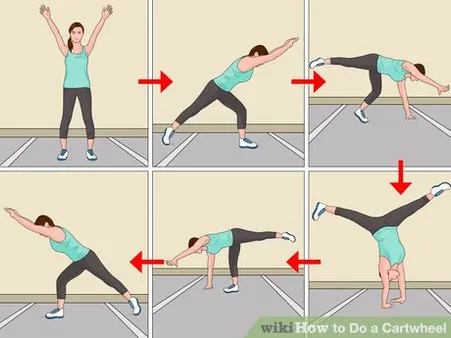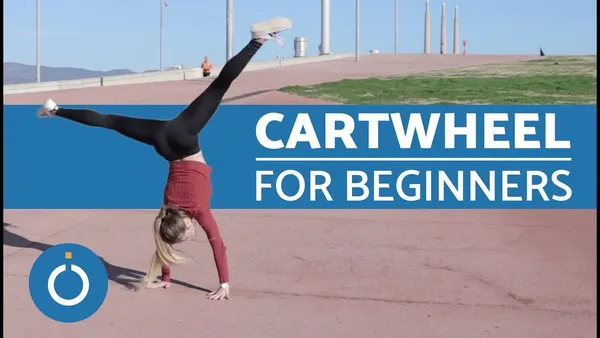Table of Contents
Welcome to Kizworld, your ultimate destination for cartwheeling mastery! Have you always been fascinated by the graceful flips and effortless movements of gymnasts performing cartwheels? With our comprehensive guide, you can unlock the secrets of this exhilarating skill and learn How to do a cartwheel like a pro. Whether you're a complete beginner or looking to refine your technique, we'll take you through every step of the process, from understanding the basics to perfecting the cartwheel technique. Get ready to experience the joy of cartwheeling and unleash your inner gymnast with kizworld!
How to Do a Cartwheel: A Step-by-Step Guide for Beginners
I. Mastering the Art of Cartwheels: A Step-by-Step Guide
Mastering the Art of Cartwheels: A Step-by-Step Guide
A Seamless Transition: Building Strength and Flexibility
Before embarking on your cartwheel journey, a solid foundation of strength and flexibility is essential. Focus on core exercises to stabilize your body, and stretching routines to enhance your range of motion. This groundwork will minimize the risk of injury and improve your overall performance.
- Core exercises: Planks, sit-ups, and leg raises.
- Stretching routines: Hamstring stretches, quad stretches, and shoulder rolls.
Kick-start your cartwheel journey with our comprehensive guide: How to Do a Cartwheel: Mastering the Fundamentals
The Art of the Technique: Perfecting the Cartwheel
With your physical base established, it's time to master the art of the cartwheel. Begin by practicing on soft surfaces like mats or grass. Break down the technique into distinct steps, focusing on each component separately before combining them into a fluid movement.
- Starting position: Stand with your feet shoulder-width apart, arms raised.
- Preparatory step: Take a small step forward with your non-dominant foot.
- Cartwheel initiation: Bend your knees and lunge forward, placing your hands on the ground.
- Body rotation: Push off with your non-dominant foot and swing your legs over your head.
- Landing: As your legs pass over, straighten your arms and legs to land on your dominant foot.
Explore our in-depth guide for a step-by-step breakdown: Cartwheel Mastery: A Step-by-Step Guide to Flawless Flips
Common Pitfalls and How to Avoid Them: A Path to Success
As you embark on your cartwheel journey, be mindful of common obstacles. Rushing through the steps or neglecting to warm up properly can lead to mistakes and potential injuries. Master the basics before attempting variations, and always prioritize safety.
Mistake | Solution |
Rushing the movement | Slow down and focus on each step. |
Improper foot placement | Ensure your feet are shoulder-width apart. |
Weak core | Strengthen your core with exercises. |
Lack of flexibility | Regularly stretch to improve flexibility. |
For a comprehensive guide to avoiding common pitfalls, check out: Common Cartwheel Mistakes and How to Avoid Them
II. Safety Measures and Preparation:
Safety Measures and Preparation:
Warm Up Properly:
Before attempting a cartwheel, it's crucial to warm up your body to prevent injuries. Start with light cardio exercises like jogging or jumping jacks to elevate your heart rate. Follow this with dynamic stretches, focusing on your shoulders, arms, back, and legs. This will help increase your flexibility and range of motion, preparing your body for the cartwheel.
Choose a Safe Environment:
Select a safe and open area with a soft surface, such as a grassy field or a gym mat. Avoid hard surfaces like concrete or asphalt, as they can cause severe injuries if you fall. Ensure the area is free of obstacles like rocks, sticks, or uneven ground to prevent tripping or stumbling.
Wear Appropriate Clothing and Footwear:
Wear comfortable and flexible clothing that allows for easy movement. Avoid loose or baggy clothes that might get caught during the cartwheel. Choose well-fitting, closed-toe shoes with good traction to provide stability and prevent slipping.
Spotter Assistance:
If you're a beginner or feel uncertain, consider having a spotter assist you. A spotter can help guide and support you during the cartwheel, reducing the risk of injury. They can also provide feedback on your technique and help you improve.
Start Slowly and Gradually Increase Difficulty:
Begin with practicing the cartwheel on your knees. This will help you get a feel for the movement and build confidence. Once you're comfortable with the basic technique, gradually progress to standing cartwheels. Start with a few repetitions and gradually increase the number as you become more proficient.
Listen to Your Body and Take Breaks:
Pay attention to your body's signals and take breaks when needed. If you feel pain or discomfort, stop immediately and rest. Pushing yourself too hard can lead to injuries. Remember, progress takes time, so be patient and consistent with your practice.
III. Executing the Cartwheel with Confidence:
Executing the Cartwheel with Confidence:
With the basics mastered, it's time to confidently execute your cartwheel. With dedication and practice, you'll be seamlessly transitioning from handstand to handstand in no time. Embracing this step requires a blend of courage, focus, and a dash of audacity. Unleash the gymnast within and prepare to witness the beautiful art of cartwheeling, effortlessly gliding through the air with poise.
- Clear Your Mind: Begin by finding a quiet space to center yourself. Engage in deep breathing exercises to calm your nerves and enhance concentration.
- Visualize Success: Close your eyes and vividly imagine performing a flawless cartwheel. Visualizing yourself executing the move flawlessly boosts your confidence and mental preparation.
- Start Small: Don't attempt a full cartwheel right away. Gradually build up your confidence by practicing handstands against a wall or with a spotter.
- Master the Handstand: Ensure you have a solid handstand before attempting a cartwheel. Practice holding a handstand for increasing durations to strengthen your core and upper body.
- Find a Safe Environment: Choose a soft, padded area like a gymnastics mat or grassy field for your practice sessions. Safety comes first.
Mistake | Solution |
Fear of Falling | Confront your fear head-on. Start with baby steps, like handstands against a wall, and gradually increase the difficulty. |
Improper Hand Placement | Ensure your hands are shoulder-width apart and directly under your shoulders. Incorrect hand placement can lead to imbalance and injury. |
Rushing the Movement | Maintain control and execute the cartwheel at a steady pace. Rushing can cause loss of balance and disrupt the flow of the move. |
Lack of Core Engagement | Engage your core muscles throughout the cartwheel to maintain stability and prevent lower back pain. |
As you progress and gain confidence, you can begin practicing the cartwheel without a spotter. Remember, practice makes perfect. Stay dedicated, embrace the challenges, and you'll soon be executing flawless cartwheels like a pro, leaving spectators in awe of your newfound gymnastic prowess.
How to Do a Handstand: A Step-by-Step Guide to Mastering the Art of Balance
IV. Troubleshooting and Perfecting the Cartwheel:
Troubleshooting and Perfecting the Cartwheel:
Mastering the Basics:
Once you've grasped the fundamental techniques, it's time to refine your cartwheel and troubleshoot any issues you may encounter. Start by ensuring proper body alignment. Your hands should be shoulder-width apart, your feet hip-width apart, and your back straight. As you initiate the cartwheel, keep your core engaged and your eyes focused on a fixed point in front of you. This will help maintain balance and control throughout the movement.
If you find yourself struggling with balance, try practicing the cartwheel against a wall or with a partner spotting you. This will provide additional support and help you gain confidence as you master the technique. Additionally, ensure you're warming up properly before attempting cartwheels. Dynamic stretches, such as leg swings and arm circles, can help prepare your body for the movement and reduce the risk of injury.
- Ensure proper body alignment: hands shoulder-width apart, feet hip-width apart, back straight.
- Keep your core engaged and eyes focused on a fixed point in front of you.
- Practice against a wall or with a partner for added support.
- Warm up with dynamic stretches before attempting cartwheels.
Overcoming Common Mistakes:
One common mistake is rushing the cartwheel. Take your time and focus on executing each step smoothly. Rushing can lead to loss of control and increased risk of injury. Another common issue is not tucking your knees enough. This can cause you to land awkwardly and potentially injure your legs or back. Make sure to tuck your knees tightly to your chest as you rotate through the cartwheel.
If you're having trouble with the handstand position, practice holding it against a wall or with a partner's assistance. This will help you build strength and stability in the position. Additionally, ensure you're landing softly on your feet, with your knees slightly bent to absorb the impact. Landing incorrectly can put unnecessary stress on your joints and increase the risk of injury.
Mistake | Solution |
Rushing the cartwheel | Take your time and focus on executing each step smoothly. |
Not tucking knees enough | Tuck your knees tightly to your chest as you rotate through the cartwheel. |
Difficulty with handstand position | Practice holding it against a wall or with a partner's assistance. |
Landing incorrectly | Land softly on your feet, with your knees slightly bent to absorb the impact. |
Building Confidence and Overcoming Fear:
Fear and lack of confidence can be significant obstacles in mastering the cartwheel. To overcome these challenges, start by practicing in a safe and supportive environment. Having a coach or experienced friend guide you through the process can provide valuable feedback and encouragement. Additionally, break down the cartwheel into smaller, more manageable steps. This will make the process less daunting and allow you to focus on each step individually.
As you progress, gradually increase the difficulty of your practice environment. Move from practicing against a wall to open spaces, and eventually try performing the cartwheel on different surfaces, such as grass or mats. This will help you adapt to various conditions and build confidence in your ability to execute the cartwheel successfully.
V. Conclusion: The Joy of Cartwheels and Beyond
With dedication and practice, you've come a long way from your first attempts at cartwheels. As you continue your cartwheeling journey, remember to embrace the joy and freedom that comes with this exhilarating skill. Cartwheels are not just about perfecting the technique; they're about expressing your inner gymnast and pushing your physical limits. Whether you're practicing in the gym or showcasing your skills at a backyard gathering, let cartwheels be a symbol of your athleticism and love for movement. As you progress, explore variations like the one-arm cartwheel or the round-off cartwheel to add an extra layer of challenge and excitement. Cartwheeling is a skill that will stay with you for life, offering endless opportunities for joy, fitness, and personal growth. So keep practicing, keep improving, and keep cartwheeling!